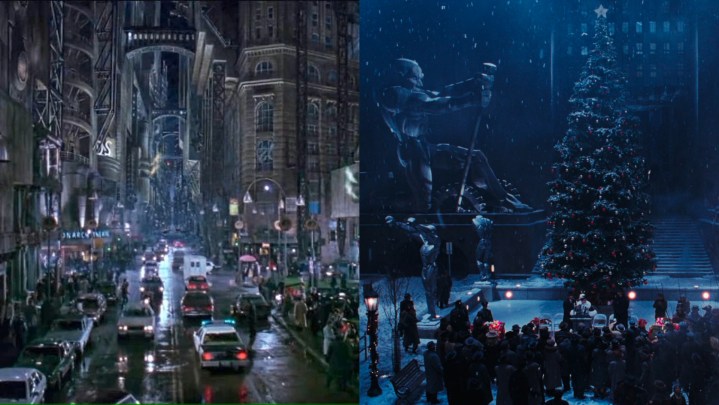With the enticing expansion of Matt Reeves and Robert Pattinson’s The Batman universe, it’s once again an exciting time for the character in the theatrical space, and the recent release of WB Games Montréal’s Gotham Knights has once again highlighted how the city itself is such an important backdrop. As cheesy as it might be to say, Gotham City truly helps elevate the Dark Knight’s tales when treated as a metaphorical character of his world.
The gloomy, crime-noir city that seems perpetually dark and stormy is the foundation that serves Batman’s wider mythos, whether it’s in Christopher Nolan’s standard-setting The Dark Knight trilogy or Paul Dini and Bruce Timm’s hallowed Batman: The Animated Series. And even though Gotham is often characterized by such moody adjectives, there have still been several attractive iterations of it across mediums to serve their aforementioned and respective functions.
From the page to the big screen

Batman and, by extension, Gotham City both have a long history in the cinematic space, even if it wasn’t as prominent in decades past. Perhaps the first major theatrical portrayal of the character and his world was in director Tim Burton’s duology, comprising the Michael Keaton-led Batman and Batman Returns.
While Burton and his depictions of the Caped Crusader himself in his corner of the DC universe don’t exactly make a secret of not paying homage to the source material that paved the way for them, it’s hard not to respect the filmmaker’s vintage brand of gothic eccentricity. That goes doubly for the leading man and Gotham City itself. One could even argue that Burton’s Gotham has more character and style than Nolan’s iteration.
It oozed with moodiness in a way that, ironically, would feel right at home in a DC comic book series. Throwing in a flavor of Christmas-themed aesthetics in Returns made it an even more aesthetically memorable incarnation of the city.

Even so, Christopher Nolan’s take on Batman and the city around him served its purpose: the first mix of modern grit and realism in a live-action rendition of the brooding superhero. Of the three films in the revered trilogy, Batman Begins arguably feels the most larger-than-life.
It might come off as jarring to some fans how the aesthetics change rather noticeably from Batman Begins to The Dark Knight and The Dark Knight Rises, but these depictions are still well in service of the atmospheres in each movie. The grimy, gothic style of Begins fits seamlessly with a gritty movie that still balances a dash of the comic book medium’s inherent brand of campiness.
The stylized nature of Begins works as well for a plot surrounding an international terrorist group comprised of ninjas trying to plunge Gotham City into a fear-toxin-induced hellscape as it does with the Michael Mann-esque crime drama setting for a story detailing a mad anarchist’s exploits — or a war epic.

However, Reeves’ The Batman, with special thanks to cinematographer Greig Fraser, feels like a proper return to form when it comes to portraying Gotham City as a background character. It’s perhaps the most lively depiction since Burton’s duology.
This Gotham City injects the perfect amount of gritty realism with an overall feel to it that seems like it was lifted off the pages of Frank Miller’s seminal Year One comic book.
Gotham feels alive, if only barely, which is perfectly in character for such a setting. The city is hooked up to its own IV for a lifeline, while at the same time working as excellent stage dressing for the heroes, villains, and everyone in between that populate it.
Batman has always felt like a character that could justify a whole cinematic universe of his own — with the help of his supporting cast and home city. The Batman encapsulates just that, which makes its on-screen future so exciting.
Animation on the small screen

Similarly, Batman also has an extensive history in the TV space. Even so, the one that undoubtedly means the most to the majority of longtime fans is the intoxicating world crafted by Paul Dini and Bruce Timm in Batman: The Animated Series and onward.
The DC Animated Universe, and the Dark Knight’s slice of it especially, are practically sacrosanct to veteran fans of the hero. And it’s a solid argument to have, as The Animated Series, the successor shows it spawned, and the beloved Mask of the Phantasm are commonly hailed as the truest-to-character portrayal of the character when taking the source material into account.
A massive part of that is, once again, the realization of Gotham City throughout. It was ingenious art direction on the creative team’s part, as they took 1940s urban aesthetics and the art deco stylistic approach to create the affectionately dubbed “dark deco” that The Animated Series popularized. The police blimps, the uses of blacks, grays, and reds, and more proved to be the perfect cocktail for an animated crime-noir atmosphere that stood the test of time.
It’s a gold standard in many ways, whether for Gotham’s visuals or how it lends itself thematically to Batman storytelling, and the upcoming Caped Crusader animated series (also in part helmed by Timm) has a lot to live up to.
In the world of gaming

When it comes to gaming, Batman didn’t truly come into his own until Rocksteady came along and did a long-awaited and Nolan-like reinvention of his universe with the Arkham series.
Arkham Asylum, setting-wise, was literally a sliver of Gotham City since it took place exclusively in the titular asylum and the island it was built on. However, it was City and the evolution of open-world game design that gradually pushed Gotham towards reaching the potential of his grim splendor in the medium.
Arkham Knight was that fully-realized potential, with the power of the PlayStation 4, Xbox One, and then-modern PC hardware putting to screen a magnificent neo-noir version of Gotham City. In terms of story, it also helped that the Arkham games have been lauded fairly consistently across its four entries — counting WB Games Montréal’s prequel — for being a slightly aged-up and video game version of what Dini and Timm accomplished with The Animated Series.

It’s another high standard to meet but, for what it’s worth, the team at WB Montréal devoted a lot of developer time to their latest effort in Gotham Knights. This is their second foray into Gotham City, and it’s an even more challenging one in a sense, as it’s a Gotham without a Batman to venture through it.
The burden is now on his extended Bat-family’s shoulders to fill the hole that his mantle leaves behind. Though it might not be as visually striking as the open world of Arkham Knight, the artistic foundation for WB Montréal’s action RPG is in the right place.
A combination of neon and grime is arguably one of the best ways to showcase the city, and the developer team’s efforts here have resulted in the largest open-world Gotham City in gaming to date.
But as tantalizing as Gotham looks with these splashes of brooding artistic elements, each one shows how versatile it is as a setting as well as how it will always be one of the pillars in Batman lore.
Warner Bros. Discovery’s various Batman movies and shows are available to stream now on HBO Max, and WB Games Montréal’s Gotham Knights is available now for PlayStation 5, Xbox Series X|S, and PC.
Editors' Recommendations
- Why The Dark Knight is still the best comic book movie of all time
- Who is the best Joker ever? We rank all the actors who have played Batman’s No. 1 enemy
- Here’s why Clayface should be the main villain in The Batman Part II
- Why The Batman universe doesn’t need the DCEU
- The best Batman movies and shows on HBO Max




